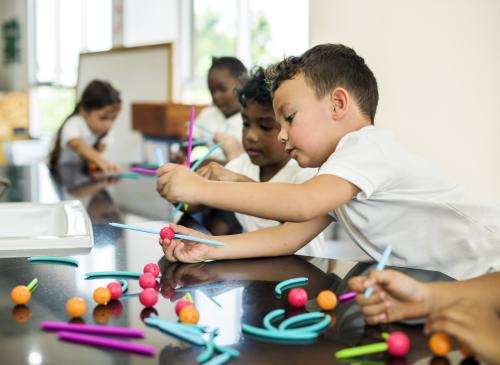We are gathered today to mourn the latest National Assessment of Educational Progress (NAEP) scores. The headlines rang forth as the New York Times proclaimed, “The Pandemic Erased Two Decades of Progress in Math and Reading” and “Math Scores Fell in Nearly Every State, and Reading Dipped on National Exam.” The dip was particularly pronounced for low-performing students who come from traditionally underserved environments. In an attempt to resuscitate the ailing scores, Martin West of the Harvard Graduate School of Education is quoted as saying that we should find ways to “increase instructional time.”
There are clearly troubling signs from these latest reports, but it does help to put this data into the larger context, looking at patterns of assessment performance over time. We are amid an educational crisis that has been brewing for decades and that was exacerbated during the pandemic. For example, the Programme for International Student Assessment (PISA) is an international test that has been given to a sample of 15-year-olds from across the globe for 22 years. American students’ scores have remained fairly stable for about the past two decades—consistently around average among participating nations. Our scores represent achievement levels demonstrating that our students can memorize content, but cannot use the content they know to solve complex problems.
Our scores represent achievement levels demonstrating that our students can memorize content, but cannot use the content they know to solve complex problems.
In terms of student performance, the latest NAEP scores tell a similar story to the PISA results. It is important to state from the outset that NAEP proficiency is not synonymous with grade level proficiency on other assessments. Furthermore, Tom Loveless cautioned that aiming for NAEP proficiency is a high academic standard to achieve. In a previous blog for Brookings, he argued “If high school students are required to meet NAEP proficient [levels] to graduate from high school, large numbers will fail. If middle school and elementary school students are forced to repeat grades because they fall short of a standard anchored to NAEP proficient, vast numbers will repeat grades.” Proficiency in math on the NAEP entails consistently applying procedural and conceptual understanding to solve problems in the following areas: number properties and operations, measurement, geometry, data analysis (including statistics and probability), and algebra. In reading, proficiency encompasses skills such as the ability to identify main ideas, to integrate information and make connections between parts of a text, and to provide a judgment about an author’s argument.
Yet, as the headlines above illustrate, the latest NAEP results continue to raise alarm about the state of American education in general. For example, just 37 percent of fourth graders were at or above proficient in math and 33 percent were at or above proficient in reading. Among eighth graders, 27 percent were at or above proficient in math, with 31 percent at or above that level in reading.
These achievement levels were eerily similar in 2019. At that time, 41 percent of fourth graders were at or above proficiency in math, with 35 percent at that level in reading. Meanwhile, eighth graders achieved 34 percent at or above proficiency in math and 33 percent in reading. It is concerning that students lost ground during the pandemic, but NAEP proficiency was relatively low pre-pandemic, as well. Further, a report shows that while there is growth from 1978 to 2020, there have been drops in scores in the past. A report from Chalkbeat on October 24 even suggests that scores have been erratically on the decline since 2015.
Professor West alludes to the fact that we need to do better at training students so that they will in turn do better on narrowly construed tests of reading and math. While it is indeed critical to learn reading and math, this raises two questions: Are tests in reading and math the most important ways to examine student achievement and growth? And will more instruction that forces teachers to teach to the test help our children really learn? We tried this tactic during the era of No Child Left Behind. In its aftermath, we spent more time on reading and math, drilled and killed our students, and even reduced their recess time. Scores did not show marked increases.
Perhaps it is time to rethink what counts as success in education today? This question was recently examined in the New York Times opinion section on September 1, 2022. There, writers argued that education is about more than content. Content is key, but so too is learning how to navigate social relationships, to become better citizens, to explore ideas that are different than our own, and to think critically and creatively. Might it be time to rethink the product of our education system and to ask how to prepare and test students for life in a 21st century world?
Peter Drucker, the father of modern management once said, “The assumptions on which most businesses are being run no longer fit reality.” In Elizabeth Edersheim’s The Definitive Drucker, Drucker adds “We are at a moment of transition where businesses and organizations will be redefined. If they don’t they’ll go the way of the pterodactyls.” Substitute the word education for the word business and these statements ring hauntingly true.
Making schools work
The science of learning offers a blueprint of how children in our future can and will succeed. For the last three decades, researchers made enormous progress in understanding how human brains learn. If we can teach in a way that capitalizes on these findings—if we can apply the science to the classrooms—we will have evidence-based ways of helping children grow the suite of skills that will make them successful in today’s classrooms and the workplaces of tomorrow. Our Brookings report, A New Path to Educational Reform and our book Making Schools Work: Bringing the Science of Learning to Joyful Classroom Practice, detail how this research in the science of learning can offer a scalable, evidenced based path to re-invigorating and re-imagining education for our time.
Children learn when they are active, not passive observers of what is taught. Children learn when they are engaged in the material and not distracted, when the information is meaningfully connected to their knowledge in ways that are culturally responsive. They learn best in social contexts, when there are strong teacher-student and peer relationships, when the information is iteratively presented multiple times in slightly different ways, and when the learning is joyful. Yes, it is possible to have joyful teaching that affords deeper learning. When we teach in ways that the brain learns, the learning “sticks” and generalizes to new problems and new solutions.
Yes, it is possible to have joyful teaching that affords deeper learning.
Children who learn in this way are more likely to be collaborators and communicators, to know their content, to be good critical thinkers and creative innovators, and to have the confidence that supports grit and a growth mindset. When schools provide a broader suite of skills, scores will likely go up on standardized tests of reading and math, as we also create socially competent, critical thinkers and creative innovators who will be valued citizens in a global world.
The NAEP scores are lower this year and this is a cause for concern. But this does not mark the irreversible decline and “death” of the American education system, nor does it prevent students from living full and productive lives. The death knell we are reading in today’s headlines might rather be the opportunity we need to rethink education and make it relevant for our time.










Commentary
An obituary for education—or not?
November 8, 2022